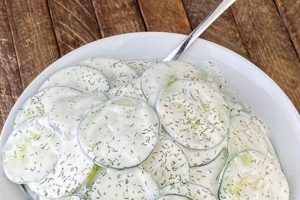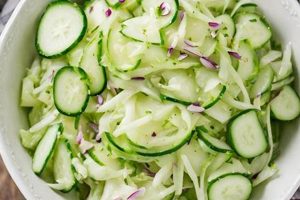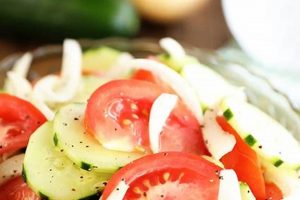A simple dish of combined sliced tomatoes and cucumbers typically forms the base of this refreshing salad. Variations often incorporate additional ingredients such as onions, herbs, and various dressings to enhance the flavor profile. A basic vinaigrette featuring oil and vinegar is common, while additions like feta cheese, olives, or lemon juice introduce further complexity. Detailed instructions for creating these salads are readily available, ranging from quick everyday versions to more elaborate preparations for special occasions.
The appeal of this type of salad lies in its hydrating qualities, derived from the high water content of both cucumbers and tomatoes. It offers a light and flavorful accompaniment to heavier meals, particularly during warmer months. Its nutritional value is another significant benefit, providing vitamins, minerals, and antioxidants. Historically, the combination of cucumbers and tomatoes has been a staple in various cuisines, especially in regions where these vegetables are readily available. This long-standing popularity underscores its versatility and enduring appeal as a simple yet satisfying dish.
The following sections will delve into specific variations of this salad, exploring ingredient choices, dressing options, and techniques for maximizing flavor and presentation. Nutritional information and health benefits will also be examined, providing a comprehensive understanding of this culinary staple.
Tips for a Perfect Tomato Cucumber Salad
Achieving optimal flavor and texture in a tomato cucumber salad relies on a few key techniques. Attention to detail in ingredient selection and preparation significantly elevates this simple dish.
Tip 1: Salt the cucumbers: Salting sliced cucumbers draws out excess moisture, preventing a watery salad. Place cucumber slices in a colander, sprinkle with salt, and let sit for 15-20 minutes before rinsing and drying.
Tip 2: Choose ripe tomatoes: Flavor is paramount. Select ripe, in-season tomatoes for the best taste. Consider heirloom varieties for diverse flavors and colors.
Tip 3: Balance acidity: A well-balanced dressing is essential. Acidity from vinegar or lemon juice complements the sweetness of tomatoes and the mildness of cucumbers. Adjust the balance to preference.
Tip 4: Add red onion sparingly: Red onion adds a sharp bite. Use sparingly to avoid overpowering the delicate flavors of the other vegetables. Soaking thinly sliced red onion in cold water can mellow its intensity.
Tip 5: Fresh herbs enhance flavor: Fresh herbs like dill, mint, or parsley elevate the salad. Add chopped herbs just before serving to preserve their vibrancy.
Tip 6: Consider adding feta cheese: Crumbled feta cheese introduces a salty, tangy dimension. Other cheeses, such as goat cheese, can also complement the salad.
Tip 7: Use high-quality olive oil: A good-quality extra virgin olive oil forms the base of many dressings, contributing significantly to the salad’s overall flavor.
By following these tips, one can create a tomato cucumber salad that is not only refreshing and nutritious but also a testament to the impact of careful preparation.
The combination of fresh ingredients, balanced flavors, and proper techniques results in a dish that is greater than the sum of its parts. The following section will conclude with some final thoughts on variations and serving suggestions.
1. Fresh, Ripe Ingredients
The foundation of a successful tomato cucumber salad rests upon the quality of its primary components: tomatoes and cucumbers. Freshness and ripeness significantly impact the flavor, texture, and overall enjoyment of the dish. Subpar ingredients result in a bland, watery, and ultimately disappointing salad. Utilizing high-quality produce elevates this simple combination to a refreshing and flavorful experience.
- Tomato Selection
Ripe tomatoes offer a balance of sweetness and acidity. Look for tomatoes with vibrant color, smooth skin, and a slight give when gently squeezed. In-season tomatoes, grown locally whenever possible, generally offer superior flavor. Heirloom varieties provide a range of colors and flavor profiles, adding visual interest and complexity to the salad.
- Cucumber Selection
Cucumbers should be firm and free from blemishes. Avoid overly large cucumbers, which tend to have larger seeds and a more watery flesh. Smaller varieties, such as Persian cucumbers, offer a crisper texture and more delicate flavor. English cucumbers, known for their thin skin and minimal seeds, are another excellent choice.
- Optimal Ripeness
Peak ripeness is crucial for both tomatoes and cucumbers. Underripe tomatoes lack sweetness and may possess a slightly bitter taste. Overripe tomatoes become mushy and lose their structural integrity. Similarly, overripe cucumbers develop a bitter flavor and soft texture. Careful selection ensures the ideal balance of flavor and texture in the final salad.
- Storage and Handling
Proper storage maintains freshness. Store tomatoes at room temperature, away from direct sunlight. Refrigeration can diminish their flavor. Cucumbers, however, benefit from refrigeration, which helps maintain their crispness. Handle both vegetables with care to avoid bruising or damage, which can accelerate spoilage and negatively impact the salad’s overall quality.
The emphasis on fresh, ripe ingredients underscores the importance of quality produce in achieving a superior tomato cucumber salad. The selection, handling, and storage of these core components directly influence the final dish’s taste and texture. By prioritizing these factors, one ensures a refreshing and flavorful culinary experience.
2. Balanced Vinaigrette
A balanced vinaigrette is crucial for a successful tomato cucumber salad. It provides the acidic element that complements the vegetables’ inherent flavors without overpowering their delicate profiles. A poorly constructed vinaigrette, whether too acidic, too oily, or lacking in complementary flavors, can detract significantly from the salad’s overall quality. The balance of acidity, oil, and seasonings determines the dressing’s efficacy in enhancing the dish.
- Acidity Level
The acidity level dictates the vinaigrette’s brightness and its ability to cut through the richness of the oil. Common acidic components include vinegar (red wine, white wine, balsamic) and lemon or lime juice. The specific acid chosen contributes unique flavor nuances. Too much acid creates an overly sharp dressing, while too little results in a bland, oily mixture. The ideal balance brightens the salad without overwhelming the other flavors.
- Oil Selection
Oil provides body and richness to the vinaigrette. Extra virgin olive oil is a frequent choice, imparting a fruity and peppery flavor. Other oils, such as avocado or grapeseed oil, offer neutral flavor profiles, allowing the other ingredients to shine. The oil-to-acid ratio is crucial; a typical starting point is a 3:1 ratio of oil to acid, adjustable according to preference.
- Complementary Seasonings
Seasonings add depth and complexity. Salt and pepper are fundamental, enhancing the overall flavor profile. Fresh or dried herbs, such as dill, mint, or oregano, introduce aromatic notes. Minced garlic or shallots add pungent accents. Sweeteners like honey or maple syrup can balance the acidity and add a touch of sweetness. The selection of seasonings depends on the desired flavor profile and should complement the vegetables.
- Emulsification
Proper emulsification creates a stable and cohesive vinaigrette, preventing separation of oil and acid. Whisking the ingredients vigorously or using a blender creates a temporary emulsion. Adding an emulsifying agent, such as Dijon mustard or a small amount of egg yolk, creates a more stable emulsion, ensuring a consistently flavorful dressing that coats the salad ingredients evenly.
The interplay of these elements creates a vinaigrette that elevates the tomato cucumber salad. The careful balance of acidity, oil, and seasonings contributes not only to the flavor but also to the overall texture and enjoyment of the dish. A well-executed vinaigrette transforms simple ingredients into a cohesive and refreshing culinary experience.
3. Proper Slicing Technique
Proper slicing technique significantly influences the final quality of a tomato cucumber salad. Uniformity in slicing ensures even distribution of flavor and dressing, contributing to a more aesthetically pleasing and palatable dish. Inconsistently sized pieces lead to uneven marinating; smaller pieces may become overly saturated with dressing while larger pieces remain underdressed. This disparity creates an imbalance of flavor and texture throughout the salad.
Consider the impact of slice thickness. Thinly sliced cucumbers and tomatoes offer a delicate texture and readily absorb the vinaigrette’s flavors. Conversely, thicker slices provide more substantial texture and retain individual flavor profiles more distinctly. The choice of thickness depends on the desired outcome and personal preference. For instance, a salad intended as a light accompaniment might benefit from thinner slices, while a more substantial salad could utilize thicker slices.
Knife sharpness plays a crucial role. A sharp knife produces clean cuts, preserving the vegetables’ structural integrity. A dull knife crushes the delicate cell walls, releasing excess moisture and resulting in a watery salad. This loss of moisture not only dilutes the flavor but also compromises the crispness of the vegetables, particularly cucumbers. Maintaining sharp knives is essential for achieving optimal results.
Beyond the practical considerations of even marinating and texture, proper slicing technique also contributes to the visual appeal of the salad. Uniformly sliced vegetables create a more professional and appetizing presentation. Attention to detail in this aspect elevates the dish from a simple combination of ingredients to a carefully constructed culinary creation. The visual appeal enhances the overall dining experience, making the salad more enticing and enjoyable.
4. Optional additions (herbs, feta)
While a basic tomato cucumber salad relies on the core ingredients for its refreshing nature, optional additions introduce layers of complexity and elevate the dish from simple to sophisticated. These additions, primarily fresh herbs and cheeses like feta, contribute not only to flavor enhancement but also to textural and aromatic diversity. Judicious selection and application of these optional components can significantly impact the overall sensory experience.
- Fresh Herbs
Fresh herbs contribute brightness and aromatic complexity. Dill, mint, parsley, and oregano are popular choices, each imparting a distinct character. Dill offers a slightly tangy, anise-like flavor that complements cucumbers. Mint provides a cooling element. Parsley contributes a fresh, herbaceous note. Oregano introduces a slightly earthy, pungent aroma. The choice of herbs depends on the desired flavor profile and should complement the existing ingredients. Overuse can overwhelm the delicate flavors of the tomatoes and cucumbers, so moderation is key.
- Feta Cheese
Feta cheese introduces a salty, tangy dimension and a creamy texture. Its crumbly nature contrasts with the crispness of the cucumbers and the juiciness of the tomatoes. The saltiness of the feta enhances the sweetness of the vegetables and balances the acidity of the vinaigrette. Other cheeses, such as goat cheese or ricotta salata, offer similar textural and flavor profiles and can be substituted based on preference. The quantity of cheese should be balanced; too much can dominate the salad, obscuring the fresh vegetable flavors.
- Other Savory Additions
Beyond herbs and cheese, other savory additions can further enhance the salad. Kalamata olives introduce a briny, salty element. Capers contribute a sharp, piquant flavor. Chopped red onion adds a pungent bite, although it should be used sparingly to avoid overpowering the other flavors. These additions, while optional, provide opportunities to customize the salad and cater to specific palates.
- Balancing Flavors
The key to successfully incorporating optional additions lies in balance. The goal is to enhance the existing flavors of the tomatoes and cucumbers, not to mask them. Start with small quantities and taste as you go, adjusting the amounts according to preference. Consider the overall flavor profile you aim to achievewhether herbaceous, tangy, salty, or a combinationand select additions that contribute to that goal harmoniously.
These optional additions offer a pathway to personalize the tomato cucumber salad, transforming it from a simple side dish into a more complex and satisfying culinary creation. The thoughtful incorporation of herbs, cheeses, and other savory elements elevates the salad, providing a broader spectrum of flavors, textures, and aromas. The ultimate success lies in achieving a harmonious balance that enhances the inherent qualities of the core ingredients.
5. Chilling before serving
Chilling a tomato cucumber salad prior to serving significantly impacts the final dish. Lowering the temperature enhances the crispness of the cucumbers and allows the flavors of the tomatoes, cucumbers, and dressing to meld. This intensified flavor integration creates a more cohesive and refreshing sensory experience. Conversely, serving the salad immediately after preparation results in a less pronounced flavor profile and a potentially less satisfying textural contrast between the cucumbers and tomatoes. The temperature difference affects the perception of sweetness and acidity, with chilled ingredients often perceived as more refreshing, particularly in warm weather. Consider a summer picnic scenario: a chilled salad offers a welcome respite from the heat, while a room-temperature salad might feel less invigorating.
The duration of chilling influences the degree of flavor melding and textural change. A brief chilling period of 30 minutes primarily enhances the crispness of the cucumbers. Longer chilling, up to two hours, allows for more thorough flavor integration between the dressing and vegetables. However, excessive chilling, beyond two hours, can lead to undesirable textural changes. Cucumbers may become overly soft, and tomatoes may lose their optimal texture. Balancing chilling time against the desired outcome ensures optimal quality. For instance, a salad with delicate herbs might benefit from a shorter chilling time to preserve their vibrant flavors, while a more robust salad could withstand longer chilling.
Chilling, therefore, represents a critical step in optimizing a tomato cucumber salad. It is not merely a matter of temperature preference but a technique that influences flavor integration, textural contrast, and overall enjoyment. Understanding the impact of chilling allows for informed decisions regarding preparation timing and ultimately contributes to a more satisfying culinary outcome. This seemingly minor detail exemplifies how seemingly simple culinary practices can significantly influence the final product. The thoughtful application of such techniques elevates the tomato cucumber salad from a basic combination of ingredients to a carefully considered culinary creation.
Frequently Asked Questions
This section addresses common inquiries regarding the preparation and enjoyment of tomato and cucumber salads, offering practical guidance for achieving optimal results.
Question 1: How can excess moisture in a tomato cucumber salad be prevented?
Salting the cucumbers before adding them to the salad draws out excess water. Slice the cucumbers, sprinkle them with salt, and let them sit for 15-20 minutes. Rinse and thoroughly dry the cucumbers before combining them with the other ingredients. This step prevents a watery salad.
Question 2: What type of vinegar is best suited for the vinaigrette?
Various vinegars, including red wine vinegar, white wine vinegar, apple cider vinegar, and balsamic vinegar, can be utilized. The choice depends on the desired flavor profile. Red wine vinegar offers a robust flavor, while white wine vinegar provides a milder tang. Apple cider vinegar adds a slightly sweet note, and balsamic vinegar contributes a rich, complex sweetness. Experimentation is encouraged to determine individual preference.
Question 3: Can this salad be prepared in advance?
While the salad benefits from chilling, it is generally recommended to add the dressing shortly before serving. Prolonged exposure to the vinaigrette can cause the vegetables, particularly the cucumbers, to become overly soft. Preparing the components in advance and combining them just before serving ensures optimal texture and flavor.
Question 4: How can one prevent the red onion from overpowering the salad?
Soaking thinly sliced red onion in cold water for 10-15 minutes mellows its intensity. This step removes some of the onion’s pungency while retaining its crisp texture and color. Alternatively, using a smaller quantity of red onion or substituting with a milder variety, such as white or sweet onion, can achieve a similar effect.
Question 5: What are some suitable herb alternatives if fresh herbs are unavailable?
While fresh herbs offer the most vibrant flavor, dried herbs can be substituted in a pinch. Use approximately one-third the quantity of dried herbs compared to fresh. However, it is important to note that dried herbs possess a more concentrated flavor and can easily overpower the salad if used excessively. Exercise caution and adjust quantities according to taste.
Question 6: How can the salad be adapted for different dietary restrictions?
The inherent simplicity of this salad allows for easy adaptation to various dietary needs. For vegan diets, omit the feta cheese or substitute with a plant-based alternative. Gluten-free diets require no modification, as the basic recipe is inherently gluten-free. Adjusting the type and quantity of oil in the vinaigrette caters to specific fat or calorie restrictions. This versatility makes the salad a suitable option for a wide range of dietary preferences.
By understanding these frequently asked questions and applying the suggested techniques, one can consistently create a delicious and refreshing tomato cucumber salad. Attention to detail, from ingredient selection to chilling time, elevates this simple dish to a truly satisfying culinary experience.
Explore further variations and serving suggestions in the following sections.
Tomato Cucumber Salad
This exploration of tomato cucumber salad recipes has highlighted the critical elements contributing to a successful rendition of this seemingly simple dish. From ingredient selection and preparation techniques, such as salting cucumbers and utilizing peak-season tomatoes, to the delicate balance of a well-crafted vinaigrette, each step plays a crucial role in the final outcome. The potential for customization through the addition of fresh herbs, cheeses like feta, and other savory components allows for diverse flavor profiles catering to individual preferences. Proper slicing techniques and chilling time further influence the texture and overall enjoyment of the salad.
Tomato cucumber salad represents more than just a combination of ingredients; it embodies a culinary opportunity to appreciate the subtle nuances of fresh produce and the transformative power of careful preparation. The continued exploration of variations, ingredient combinations, and regional adaptations promises a deeper appreciation for this versatile and refreshing dish. Its adaptability ensures its enduring presence in culinary traditions worldwide.






